There’s a coyote about town. Several, in fact. One is the shadow you see disappearing into the dunes off Route 6, gone in such an acute flash you wonder if you imagined it.
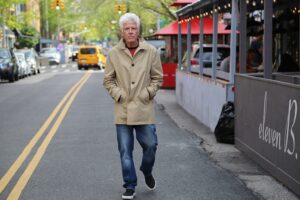
Another, the automobile’s latest victim, is hopping around on three legs, holding its broken fourth leg off the ground. It searches for food on the periphery of driveways and parking lots, slowly starving. We safely observe its pain from behind a windshield’s glass.
Yet another coyote, long dead but also viewed from behind glass, inhabits a series of photographs now on exhibit at Schoolhouse Gallery in Provincetown. Its boredom, curiosity, fear, and symbolism bark and bite across 50 years.
This coyote was named Little John. He is pictured with the German conceptual artist Joseph Beuys, who for eight hours a day from May 21 to 25, 1974 locked himself and the wild animal in a specially constructed cage at René Block Gallery in New York. Beuys called the performance “I Like America and America Likes Me.”
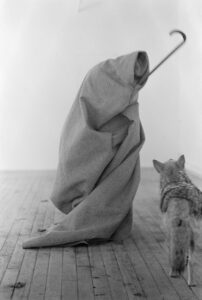
After wandering into the gallery on one of those afternoons, seeing Beuys and the coyote, and running home to get his camera, the photographer and painter Stephen Aiken, then 25 and living in SoHo, returned to the gallery and shot an entire roll of black-and-white film over the course of about an hour.
“Beuys’s performance was always about an action to create a reaction in the audience,” says Aiken, who now lives in Wellfleet with his wife, the artist Susan Hannah. “I think he was particularly aware of the fact that as you develop the new you don’t want to leave everything that was the old behind.”
“The old” was symbolically present in the coyote, the cage, and objects like straw, a triangle, a copy of the Wall Street Journal, a felt blanket, a recording of a blaring turbine, and the silence that preceded and followed it. “The new,” of course, was more conceptual, but it was based in Beuys’s aim to expand the scope and influence of art amid the upheavals and horrors of the 20th century.
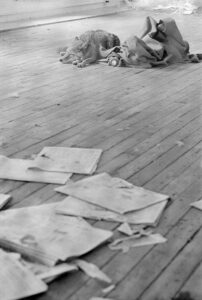
Aiken had first encountered this idea and Beuys himself a few months before, in January 1974, when Beuys hosted a public dialogue at the New School. Aiken, who was in the audience with his camera, says that Beuys spent a lot of time referencing diagrams he had drawn on the chalkboard and connecting concepts such as myth, economics, and brotherhood with an adeptness for unscripted theater that bordered on the surreal. Beuys’s bottom line was that social change has to come from the artist rather than the politician.
The images of this dialogue are included as a sort of primer to the photographs of “I Like America and America Likes Me” in Stephen Aiken: An Artist, a Coyote, and a Cage, published last month by Letter16 Press in commemoration of Beuys’s performance.
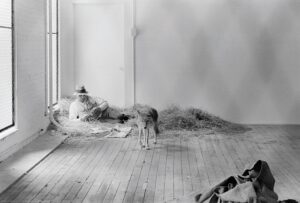
“Beuys was always after as wide an audience as possible, from credentials-draped curators to casual gallery-goers,” said Letter16 Press publisher and journalist Brett Sokol in an email. “Where and how all those folks entered the conversation was irrelevant to him, as long as they engaged on a visceral level.”
Whatever else one might have to say about him — and the critiques include his service in Nazi Germany’s Luftwaffe to the art historian Benjamin H.D. Buchloh’s characterization of him in Artforum as a “perfidious trickster” — Beuys succeeded in evoking a visceral response to his work.
In maintaining contact with the coyote and using the encounter to emphasize the distances that exist among human groups and between humans and nature, “I Like America and America Likes Me” left an indelible mark on contemporary art. Its historical importance and provocative effects only grew over time.
“Beuys viewed the United States as in a traumatic energetic block,” says Aiken. “Environmental destruction, Vietnam, the genocide of Native American people — those aren’t necessarily an answer to why this country is blocked, but they may be clues.”
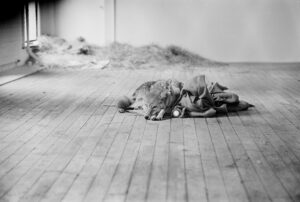
Aiken says that Beuys invited people into the space not as viewers but as participants with the capacity to call attention to these clues and other profound divisive forces in this country. Knowledge and experience — represented by the objects Beuys scattered around the room and used — were instruments of flow to foil the blockage.
In a way, activating that flow is what Aiken is doing now. His previously unpublished photographs — at Schoolhouse Gallery through July 16 — are a sliver of a sliver of the performance, but they capture a vital point of impact that lingers on the conscience like a bruise that won’t fade. He says he felt a responsibility to do something with them.
“I’m interested in people looking at this material not as a dead artifact but as something living and usable,” says Aiken.
While both the coyote and Beuys are dead, the performance certainly is not. Each person who encounters it — then just as much as now — is left enraptured and wondering: where have we come from, and where are we going?
Encountering the Umwelt
The event: Stephen Aiken’s photographs of Joseph Beuys’s 1974 performance “I Like America and America Likes Me
The time: Through July 16
The place: Schoolhouse Gallery, 494 Commercial St., Provincetown
The cost: Free



